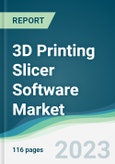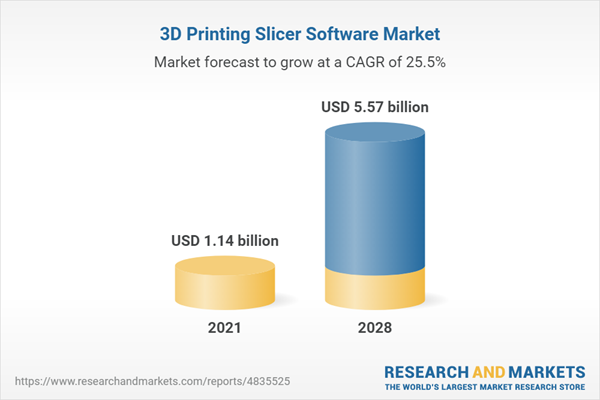The 3D printing slicer software market was valued at US$1.138 billion in 2021 and is projected to expand at a CAGR of 25.48% over the forecast period to reach US$5.573 billion by 2028.
3D printing slicer software converts the 3D model into thin slices, which a 3D printer can follow to manufacture the object, thus making it a crucial software for 3D printing. The demand for 3D printing slicer software is estimated to increase over the forecast period due to the rising integration of 3D printing across multiple end-user industries. However, piracy concerns and the increasing availability of free-license software are expected to hinder this market growth in future years. Geographically, North America and Europe are estimated to hold a significant market share owing to the early adoption of 3D printing technology in multiple industries, with the Asia Pacific region projected to see numerous growth opportunities in the coming years.This research study examines the 3D printing slicer software market based on end-user and geography segments. First, a brief market overview details key driving factors and challenges. Next, Porter's five forces model comprehensively analyzes the 3D printing slicer software industry. This is followed by industry value chain analysis which determines the companies which are part of the different processes and contributing to various sectors.
The study also presents in-depth information concerning the development, trends, and industry policies and regulations affecting the 3D printing slicer software market. Moreover, the research study analyzes the overall regulatory framework of the 3D printing slicer software sector, offering stakeholders a better understanding of the key factors influencing the overall market environment.
3D Printing Slicer Software Market - Forecasts from 2023 to 2028 is a comprehensive and latest report. It provides vital market information to executives and interested stakeholders to enable them to get vital market information. The report also analyzes the competitive landscape, details the strategies of key market players, and plots them on our vendor matrix in four quadrants: leader, follower, challenger, and niche.
The scope and coverage of the 3D printing slicer software market report are as below:
- 3D printing slicer software market data tables and charts
- Market outlook with sections on drivers, restraints, Porter's, and industry value chain analysis
- Detailed market trends, analysis, and graphical representation by end-user in healthcare, automotive, aerospace and defense, construction, and others.
- A 360 degree view of the demand for 3D printing slicer software solutions/services across different geographies (North America, South America, Europe, Middle East and Africa, and Asia Pacific) with further breakdown for key countries within those regions.
Different segments covered under the 3D printing slicer software market report are as below:
By End-User
- Healthcare
- Automotive
- Aerospace and Defense
- Construction
- Others
By Geography
- North America
- United States
- Canada
- Mexico
- South America
- Brazil
- Argentina
- Others
- Europe
- United Kingdom
- Germany
- France
- Spain
- Others
- Middle East and Africa
- Saudi Arabia
- UAE
- Israel
- Others
- Asia Pacific
- Japan
- China
- India
- South Korea
- Indonesia
- Thailand
- Others
Table of Contents
Companies Mentioned
- Autodesk Inc.
- Stratasys Ltd.
- Ultimaker B.V.
- Materialise N.V.
- 3D Control Systems Inc.
- Raise 3D Technologies Inc.
- Zortrax S.A.
Table Information
| Report Attribute | Details |
|---|---|
| No. of Pages | 116 |
| Published | June 2023 |
| Forecast Period | 2021 - 2028 |
| Estimated Market Value ( USD | $ 1.14 billion |
| Forecasted Market Value ( USD | $ 5.57 billion |
| Compound Annual Growth Rate | 25.4% |
| Regions Covered | Global |
| No. of Companies Mentioned | 7 |









